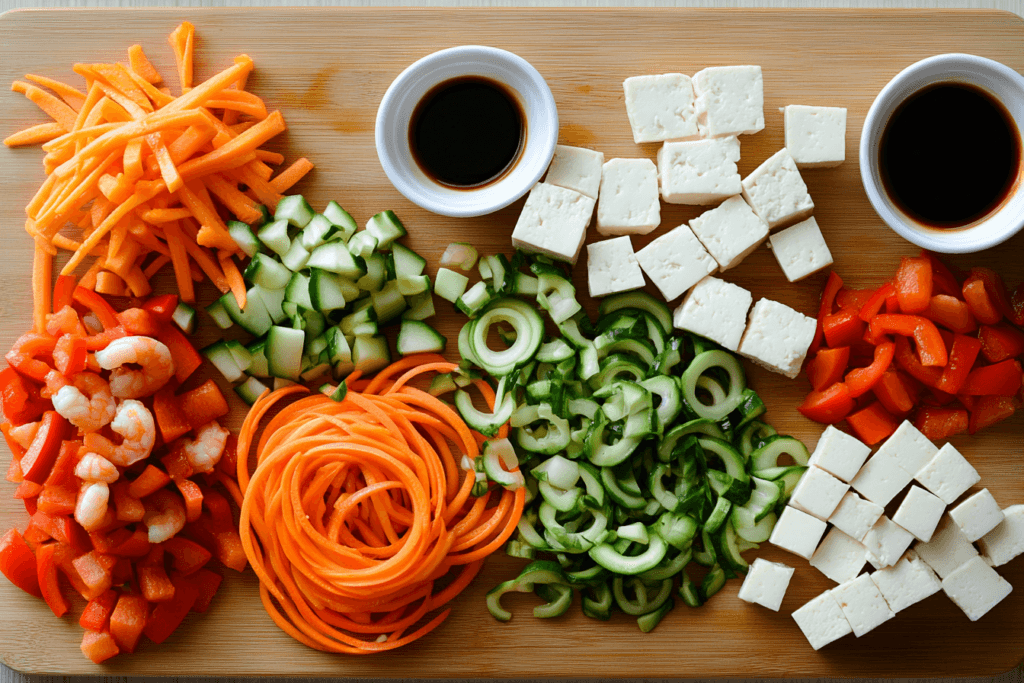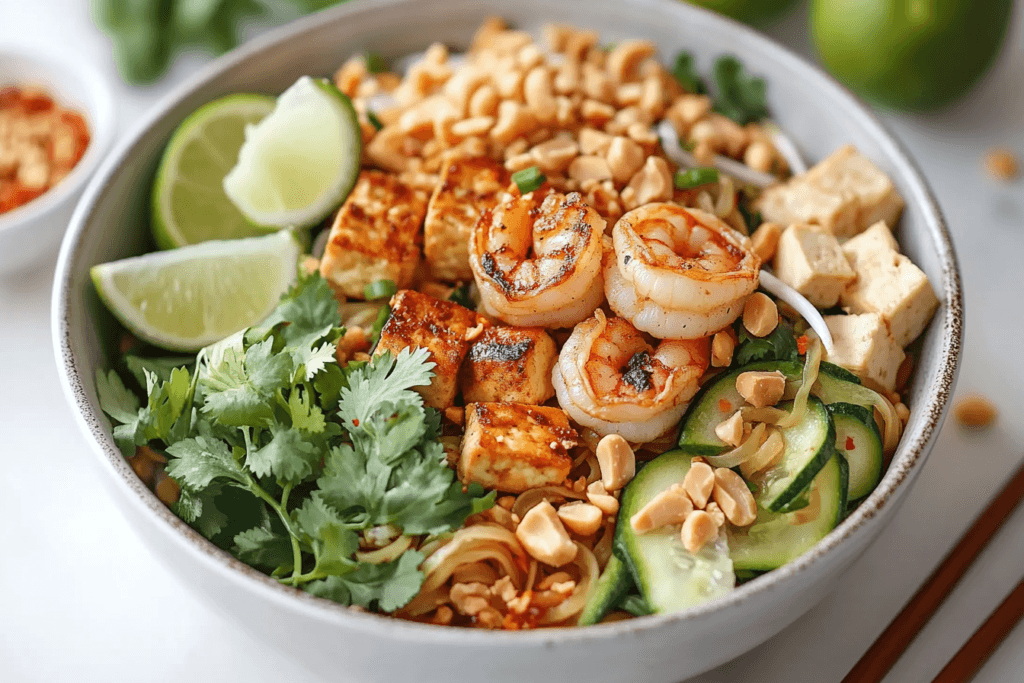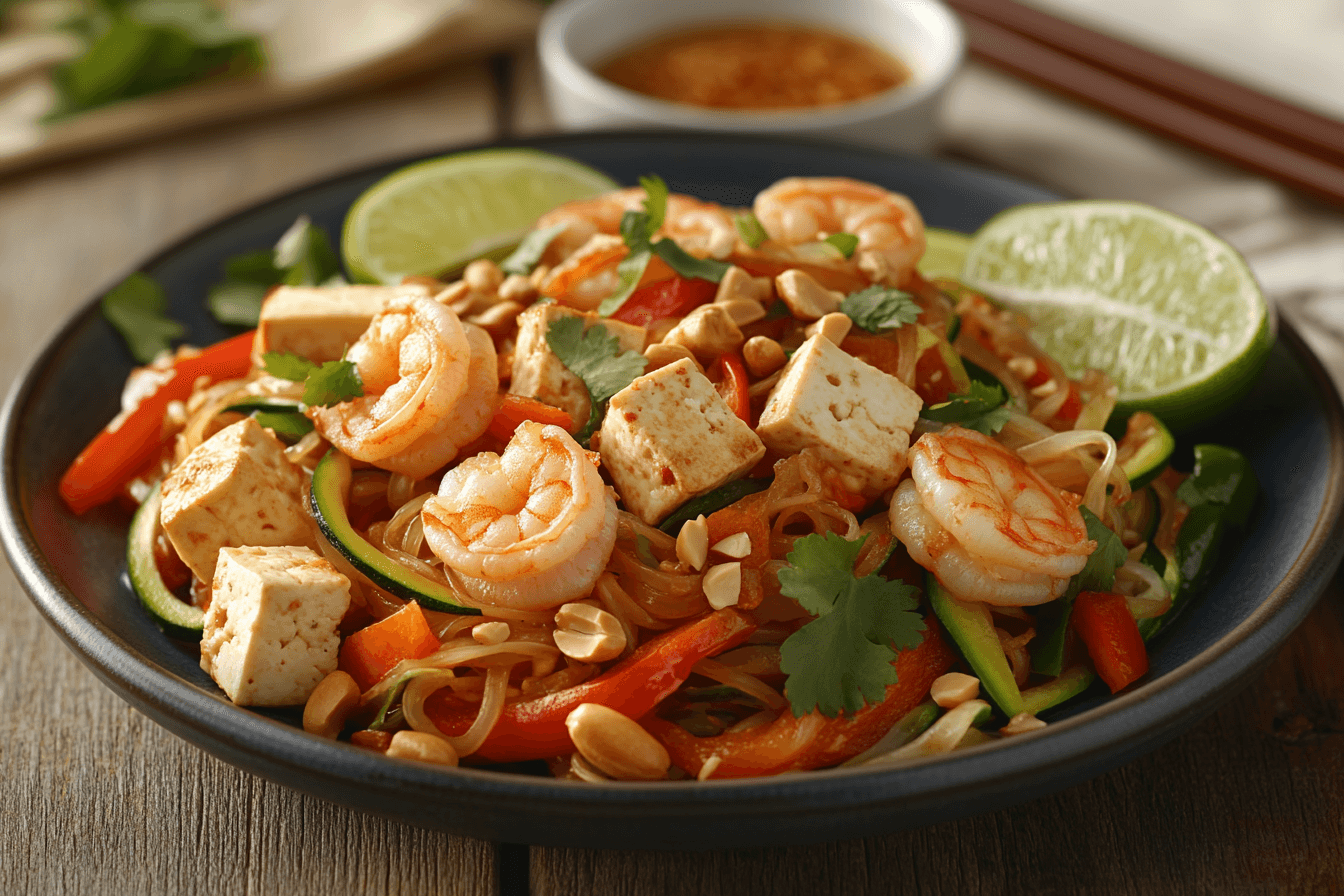H1: Healthy Pad Thai Recipe: A Complete Guide
Who doesn’t love Pad Thai? It’s the ultimate comfort food – chewy noodles, tangy sauce, and just the right amount of crunch. But let’s face it, the traditional version can be a calorie bomb. That’s where this healthy Pad Thai recipe steps in! It’s all the flavor you adore, minus the guilt. Ready to dive in? Let’s go!
Introduction to Pad Thai
Pad Thai is more than just a dish; it’s a cultural icon from Thailand that has captured hearts (and stomachs) around the globe. With its perfect balance of sweet, sour, salty, and spicy, it’s a flavor explosion in every bite. But do you know what makes it so special?
What Makes Pad Thai Unique?
Pad Thai is like a symphony of flavors. The tangy tamarind, the salty fish sauce, the nutty crunch of peanuts – it’s all about balance. Unlike Western dishes that might lean heavily on one taste, Pad Thai is an art of equilibrium.
Why Choose a Healthy Version?
Here’s the thing – traditional Pad Thai, while delicious, often packs in a ton of oil, sugar, and sodium. But who says you have to compromise? By swapping out a few ingredients and using smarter cooking techniques, you can enjoy all the flavors without the post-meal slump.
Ingredients Overview
Every great dish starts with the right ingredients. Healthy Pad Thai is no exception. Let’s break down what you’ll need to make this magic happen.
Traditional Pad Thai Ingredients
The classic recipe includes rice noodles, tamarind paste, fish sauce, sugar, eggs, tofu, shrimp, and peanuts. While undeniably tasty, some of these ingredients can be high in calories or sodium.
Healthier Substitutions for Ingredients
Looking to lighten things up? Here are some swaps:
- Rice Noodles: Try zucchini noodles or brown rice noodles.
- Sugar: Use a natural sweetener like honey or stevia.
- Fish Sauce: Opt for a low-sodium version or tamari for a vegan twist.
Key Flavors in Pad Thai
Healthy or not, Pad Thai is all about the flavor. Here’s what you’ll need to nail it:
- Tamarind Paste: The tangy backbone of the sauce.
- Lime Juice: Adds brightness and balances the dish.
- Peanuts: For that essential crunch – roasted and unsalted are your best bet.
Tools and Equipment You’ll Need
Before diving into the cooking process, make sure you have the right tools. You don’t need a professional kitchen setup, but a few essentials can make all the difference:
- Wok or Large Pan: For even heat distribution and that signature stir-fry vibe.
- Sharp Knife: To slice and dice veggies or protein.
- Tongs or Spatula: For tossing ingredients without breaking them.
- Small Mixing Bowl: To prepare your Pad Thai sauce.
Pro tip: A wok isn’t just for aesthetics—it helps with quick, high-heat cooking that preserves texture and flavor!
Step-by-Step Recipe Guide
Let’s break down the process into simple steps. By the end, your kitchen will smell heavenly, and you’ll have a plate of healthy Pad Thai ready to devour.
Preparing Your Ingredients

Preparation is key when it comes to Pad Thai. Chop, measure, and organize everything beforehand to make cooking stress-free.
- Noodles: If using rice noodles, soak them in warm water until soft but not mushy. For veggie noodles, spiralize zucchini or carrots.
- Protein: Dice tofu, slice chicken breast, or peel shrimp depending on your choice.
- Vegetables: Thinly slice bell peppers, carrots, and green onions for vibrant color and crunch.
- Sauce: Whisk together tamarind paste, low-sodium soy sauce or tamari, honey, and lime juice in a bowl.
Cooking the Perfect Pad Thai Sauce
The sauce is the heart of Pad Thai. A well-balanced sauce can take your dish from average to restaurant-quality.
- Heat a small pan over medium heat.
- Add a splash of sesame oil for nutty depth.
- Stir in tamarind paste, honey, soy sauce, and lime juice. Simmer for 2-3 minutes.
- Taste-test! Need more tang? Add tamarind. Too salty? A dash of honey will save the day.
📝 “The sauce should be rich but not overpowering—think of it as the glue that ties all the flavors together.”
Combining Everything: Cooking Pad Thai
Now comes the exciting part!
- Heat your wok over medium-high heat and add a teaspoon of oil.
- Sauté your protein (tofu, chicken, or shrimp) until cooked through, then set aside.
- Add garlic, shallots, and veggies to the wok. Stir-fry until slightly tender but still crisp.
- Push everything to one side of the pan. Crack an egg into the empty space and scramble it quickly.
- Toss in your noodles, cooked protein, and sauce. Stir everything together until coated evenly.
Final Touches: Garnishes and Presentation

No Pad Thai is complete without the finishing touches:
- Garnishes: Sprinkle roasted peanuts, fresh cilantro, and bean sprouts on top.
- Lime Wedges: Serve on the side for an extra zing.
- Chili Flakes: Add if you like a little heat.
📌 “Presentation matters! A well-plated Pad Thai is not just a treat for your taste buds but also for your eyes.”
Common Problems and Their Solutions
Even the best cooks face hiccups in the kitchen. Here’s how to tackle common issues when making Pad Thai.
Sauce Too Salty? Here’s How to Fix It
Pad Thai sauce can sometimes go overboard on saltiness, especially with traditional fish sauce. Here’s the fix:
- Add a splash of lime juice or vinegar to balance the flavor.
- Dilute with a tablespoon of water or low-sodium broth.
Balancing Flavors: Sweet, Sour, and Spicy
The hallmark of Pad Thai is its balanced flavor profile. If one taste dominates, adjust accordingly:
- Too sour? Add a pinch of honey or brown sugar.
- Too sweet? Squeeze in more lime juice or tamarind paste.
- Lacking spice? Sprinkle in chili flakes or use sriracha for a kick.
👩🍳 “Think of balancing flavors as a dance where no single partner outshines the others.”
Achieving the Right Noodle Texture
Mushy or undercooked noodles can ruin the dish. Here’s how to get it right:
- For rice noodles, under-soak them slightly since they’ll finish cooking in the wok.
- If using veggie noodles, pat them dry before cooking to prevent sogginess.
Nutritional Benefits of Healthy Pad Thai
Pad Thai isn’t just about taste—it can be a nutritious powerhouse when made with the right ingredients. Let’s dive into what makes this healthy version not only delicious but also good for you.
Macronutrient Breakdown
Healthy Pad Thai delivers a balanced mix of macronutrients:
- Carbohydrates: From rice noodles or veggie noodles, these provide the energy you need for the day.
- Protein: Whether you opt for tofu, chicken, or shrimp, it’s a fantastic source of protein for muscle repair and growth.
- Fats: The good kind! Peanuts and sesame oil contribute heart-healthy fats.
Vitamins and Minerals in Pad Thai
You’re not just eating a dish; you’re nourishing your body. Here’s what you get:
- Vitamin C: From lime juice and bell peppers, it boosts your immune system.
- Iron: Found in tofu and shrimp, essential for energy production.
- Fiber: Veggies and whole-grain noodles help with digestion.
🌟 “Think of your Pad Thai bowl as a colorful, nutrient-packed gift to your body.”
Tips for Customizing Your Pad Thai
One of the best things about Pad Thai is how versatile it is. Whether you have dietary restrictions or just want to switch things up, here’s how to customize it to your liking.
Making It Vegetarian or Vegan
It’s easy to make a plant-based version of this dish:
- Swap fish sauce for tamari or coconut aminos.
- Use tofu or tempeh as your protein.
- Add extra veggies like broccoli or snap peas for a fuller plate.
Adding Protein Options Like Tofu or Chicken
Your protein choice can completely transform the dish. Some ideas:
- Tofu: A vegetarian favorite, it absorbs the flavors beautifully.
- Chicken Breast: Lean and tender, it’s a classic option.
- Shrimp: Light and sweet, shrimp pairs perfectly with the tangy sauce.
FAQs About Healthy Pad Thai
Curious about some common questions? Let’s clear them up!
Is Pad Thai Gluten-Free?
Traditional Pad Thai can be gluten-free if you use rice noodles and ensure your tamari or soy sauce is gluten-free. Always double-check ingredient labels.
Can You Meal Prep Pad Thai?
Absolutely! Make a big batch and store it in airtight containers for up to 3 days. Reheat in a skillet for the best texture, adding a splash of water or sauce to revive the noodles.
Conclusion
Why You’ll Love This Healthy Pad Thai Recipe
Healthy Pad Thai isn’t just a recipe; it’s an experience. It brings together bold flavors, vibrant colors, and nourishing ingredients in one irresistible bowl. Plus, it’s customizable and perfect for anyone looking to enjoy a classic dish with a healthy twist.
So, what are you waiting for? Grab your wok, whip up this recipe, and treat yourself to a plate of pure deliciousness. Your taste buds (and your body) will thank you.
“A healthy lifestyle doesn’t mean giving up your favorite foods—it means finding better ways to enjoy them.”
Don’t forget to share your Pad Thai creations with friends and family. Cooking is even more enjoyable when it’s shared. Bon appétit! 🥢✨
Elevate your Healthy Pad Thai Recipe by pairing it with a vibrant Kale Quinoa Salad, offering a refreshing and nutritious side. For those looking to explore more plant-based dishes, the Vegetarian Gumbo Recipe provides a hearty and flavorful option, while the Plant-Based Recipes for Beginners is perfect for discovering new meal ideas. If you’re craving a sweet treat to finish your meal, indulge in the delightful Mini Chocolate Chip Muffins for a balanced combination of health and indulgence

